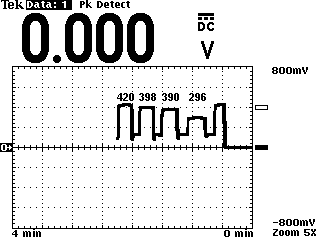
Using a Infrared Temp Probe

How many of you own an Infrared temp probe? What do you use it for? Many of you know the value of one of these gems for diagnostics, and there are many different makes and models. The one I like is in the image above connected to my Tekscope, a Fluke model 80T-IR/E, it has a range of 32-1000 degrees. The nice thing about this one, is it can be connected to a meter or scope. These things can be used in many different ways, such as locating misfire as I will illustrate on this page.

Detecting misfire in this manner will only work if you have a bare exhaust manifold to measure temp of runner at each port, many have shielding around them, some shielding will expose the flange, you might be able to get a reading there, but its best to point your probe at the area on the runner just after the flange (arrow) to take the reading, this is the hottest area, and will show the difference better. Try to stay consistent with the same location at each runner, find the one thats hardest to "see" with the probe, and use that same area on all the other runners. Depending on the type of manifold, cast, tubular, etc., temp will be anywhere from 350 degrees or more. On manifolds with mated ports, (two ports to one runner) stay to the outermost area of each side of the runner. If the miss occurs above idle, set the speed to where the miss occurs then do your measurements. Measure each port until you find the lowest reading one in temp, this will be the offender. Temp difference should be at least 75 degrees or more lower than all the rest, most will vary normally by 10- 50 degrees.

I used the probe on my scope to show you how this works, normally, I just use the probe on one of my DMM's. Above is a recording of the readings I took on this 93 Saturn 4cyl with one cylinder (number 4) shorted to kill a cylinder. The first three cylinders are around 400 degrees, number four shows a difference of almost 100 degrees less, pointing out the misfiring cylinder. Using this method is quick and dirty, and is very accurate in finding a cylinder misfire for whatever reason.